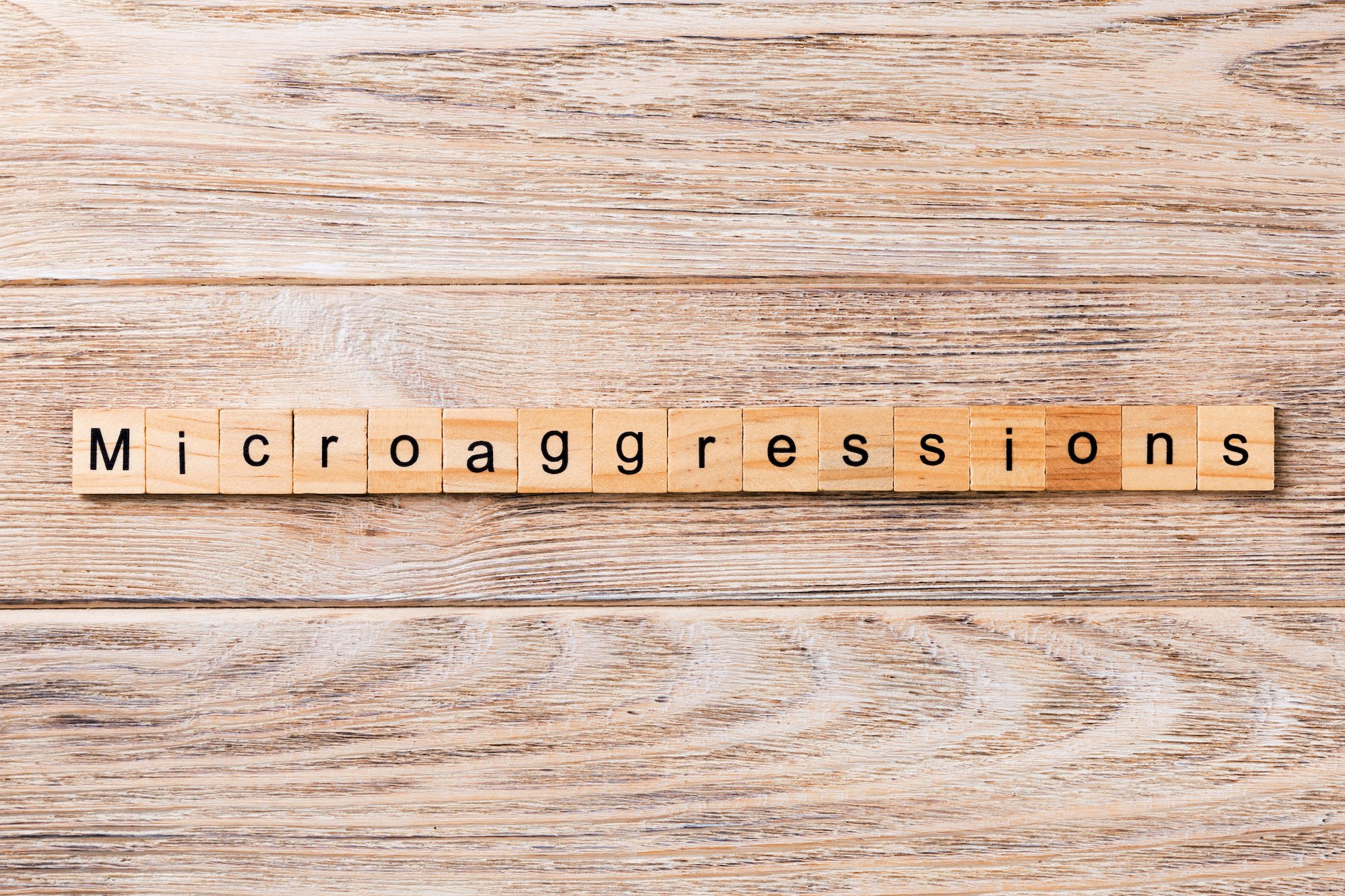You’ve probably seen it or experienced it: Nonverbal slights, insults or demeaning behaviors that target individuals from traditionally marginalized groups. And maybe it struck a chord and made you feel uncomfortable in a way you couldn’t fully comprehend in the moment. These exchanges are not unusual, and it’s only now that we are taking notice and understanding they are toxic and damaging over time. And they have a name—microaggressions.
While many of us can easily identify overt forms of discrimination in the workplace, microaggressions are often far more subtle and go unnoticed and unreported. As referenced in a Harvard Business Review article, studies indicate these actions, which are a type of bias, are “at least as harmful” as more overt forms of racism. To address these behaviors in the workplace culture, we need to understand them in greater depth.
What the research shows
Microaggressions may fly under the radar for those of us who don’t directly experience them, but they are a clear form of exclusion and discrimination—and they are more widespread than you may think. According to a study by Survey Monkey, “More than a quarter of Americans (26 percent) have definitely experienceda microaggression at work and another 22 percent are unsure. Thirty-six percent have witnessedone (with another 24 percent unsure).”
People with disabilities, minorities and women are often the recipients of these biases. “For almost two-thirds of women, microaggressions are a workplace reality,” according to McKinsey & Company and LeanIn.org’s study, in which 317 American companies participated and more than 40,000 people were surveyed. The same study states that “Black women, in particular, deal with a greater variety of microaggressions.” And in a study conducted by the Center for Talent Innovation, “34 percent of respondents with disabilities say they have experienced discrimination or bias while working at their current companies.”
Microaggressions are typically a result of implicit biases, though they may also stem from conscious biases. According to a study by the Ohio State University Kirwan Institute for the Study of Race and Ethnicity,biases, also known as unconscious biases, are attitudes, prejudices and stereotypes that influence “our understanding, actions and decisions in an unconscious manner,” which may not reflect the beliefs a person explicitly endorses. Because microaggressions are subtle acts of exclusion in everyday verbal and nonverbal behaviors, we must pay particular attention to spot them in the workplace.
Types of microaggressions and their impact in the workplace
The negative effects of microaggressions on both individuals and organizations are real. Repeated incidents can have serious emotional effects for people on the receiving end and can make it difficult for them to do their job, impacting their work performance and ability to thrive. Microaggressions can harm collaboration, affect business outcomes and eventually erode work culture. They appear in three forms as identified in a study by professors at Columbia University: microassaults, microinsults, and microinvalidations.
- Microassaults: are the explicit use of insults, slurs or other statements, behavior or imagery that convey exclusion based on a person’s characteristics. Example: refusing to work with or serve someone due to their race, national origin or other characteristic.
- Microinsults: are slights, insensitive comments, or other demeaning verbal and non-verbal conduct that carry a hidden insulting message toward the recipient. Example: when a supervisor appears distracted or disregards when a minority employee is contributing to a group discussion during a meeting.
- Microinvalidations: are statements that exclude or negate the experience of a person, resulting in the negation of their identity or heritage. Example: when a minority employee expresses they are being treated differently or unfairly by another colleague, and another employee responds that they are being too sensitive.
“As suggested by the name, microaggressions seem small; but compounded over time, they can have a deleterious impact on an employee’s experience, physical health and psychological well-being.”
— “The Value of Belonging at Work,” Harvard Business Review, December 2019
What can we do to prevent and address microaggressions?
So how do we create a workplace that is inclusive and equitable for all? Creating awareness about microaggressions is part of the answer. Leaders must take action to identify biases in their organization and take meaningful steps to address them.
Educate your teams
There are some initial steps leaders can take to both prevent microaggressions from occurring and to manage them when they do occur. An important place to start is educating employees. Comprehensive training can help every employee understand what microaggressions are and how to identify and intervene should a microaggression occur. Educating everyone in an organization on these issues can help keep offenders in check and alleviate the burden placed on those who are on the receiving end.
All too often, “Too much burden is placed on those already hurt and marginalized to do the heavy lifting when incidents occur,” says Sarah Morgan, consultant and creator of “Leading in Color” podcast, in her Fast Company article. Every employee, from every background and level of an organization, plays a role in creating a civil and positive workplace. Through quality training, employees can build the skills to respond to microaggressions and increase awareness of their own biases. For example, understanding your role as a bystander and an ally can be a powerful tool in identifying and mitigating microaggressions.
Foster a culture of support
Educating all employees will impact awareness and prevention of microaggressions. Morgan says it’s up to “leaders and HR departments” to “place the burden of correcting these issues where it belongs: on the offending individual, not the person targeted.” If an employee experiences microaggressions, the incident should be taken seriously and put through the right channels, ensuring the offending parties learn to understand the consequences of their actions. This also requires creating an environment where employees can openly offer feedback, speak up should they experience discrimination, and be supported by leadership. A culture where issues are ignored or employees fear speaking up creates a hostile work environment and allows microaggressions to persist.
Create opportunities for dialogue
Understanding individual employees’ experiences through open and ongoing dialogue with managers and human resources can also help individuals and teams work more effectively together. In these communications, HR can surface issues, recognize power dynamics, address employee concerns and get feedback on work dynamics to evaluate what’s working and what’s not. Conducting listening sessions with marginalized groups in an open forum is another way to understand their workplace experiences and make progress on key issues and concerns that may be affecting minority groups.
Create transparency through formal company policies
Leaders should evaluate, identify and remedy policies and business processes for biases. For example, standardizing how performance evaluations and promotions are given, and involving multiple stakeholders in these decisions, can reduce the more subtle biases from influencing the process, and help ensure these processes are objective and do not result in exclusionary outcomes. Training and guidelines on recruitment and hiring practices, including writing job descriptions, screening resumes and conducting interviews, are additional ways to reduce the potential for bias.
The takeaway
You can reduce incidents of microaggressions and implicit bias in your organization by implementing these key strategies:
- Reinforce a culture of respect by training employees to be aware of microaggressions and implicit bias, and their effect on individuals and the broader organization.
- Take reported incidents seriously, address issues that arise through the appropriate channels and support employees.
- Create space for open dialogue and ongoing feedback.
- Create formal policies that are inclusive and create transparency and standardization in your business processes to eliminate bias at every level of your organization.
Understanding and addressing microaggressions is an ongoing process that takes the commitment of leadership and the participation of employees across all groups and at all levels of an organization – but it will lead to a positive, more resilient and more equitable organization.












